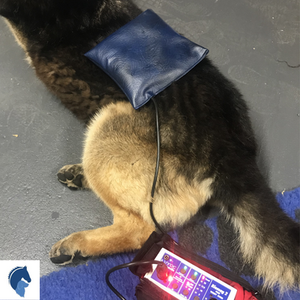I recently purchased a Pulsed Electromagnetic Field Therapy machine (Pulse Mag) and have been using it on lots of my clients, who all seem to love it! For this reason, I thought it would be interesting to choose Pulse Mag as my next 'Research Review' blog topic, to give you an insight into how it works, and what the research shows.
How does it work?
A Pulse Mag machine consists of a power unit and various different applicators or pads, which contain magnets. When the machine is on, an electric current passes through the magnets to create a low level electromagnetic field. This field has been found to primarily effect the cell membrane.

All of the cells in our body have a cell membrane, a thin layer that surrounds the cell. These membranes have a cell membrane potential which is the difference in electric potential between the inside and outside of the cell. This potential is important because it means the cell can act as a 'battery' and function correctly, and signals can be passed within the cell.
When a cell is damaged or injured the cell membrane potential is reduced, meaning the cell cannot work properly. This is where Pulse Mag steps in, as it helps to restore the normal current and voltage in the cells, by transporting ions (atoms with electric charge) across the membrane. Once the cell membrane potential is restored, the cell can function properly again.
What is Pulse Mag used for?
A Pulse Mag machine has lots of different settings which gives it a range of applications;
- Fracture Healing
- Pain Management - Chronic or Acute
- Soft Tissue Swelling or Bruising
- Wounds
- Osteoporosis and Non-Union Fractures
- Neurological Injury
So what does the research say?
To show you how effective Pulse Mag can be, I want to talk about a few clinical trials that have been carried out. Here I have focused on the benefits for osteoarthritis and pain relief, as this is what I mainly use this therapy for, however there are other trials that research the other listed effects.
Osteoarthritis (OA) is seen so commonly as either a primary or secondary issue in dogs, and this first piece of research looked at the effect of Pulse Mag on the knee joints of Guinea Pigs (Fini et al., 2008). This trial particularly focused on whether the treatment slowed down the progression of the disease, and it found that Pulse Mag did have a protective effect on the cartilage in the knees. The treatment was found to increase the production of cartilage cells, and it also had an anti-inflammatory effect, which is ideal in cases of OA where the joint can become swollen, hot, and painful.
Another trial investigated the effect of Pulse Mag therapy on OA in dogs (Pinna et al., 2012), to see if it impacted on pain relief and the functional capacity of the patient. The dogs had 20 treatments over the course of 3 weeks, and were assessed at the beginning, middle, and end of the study. The results showed that Pulse Mag improved lameness scores in 92% of the dogs, meaning they were able to put more weight on the affected limb. The dogs also showed reduced pain when the arthritic joints were touched, and owners felt that quality of life had improved. Overall this trial produced really positive results for the use of Pulse Mag in the management of OA.
Finally, I wanted to mention a human trial on Pulse Mag's effect on back pain - as the Vet Physio industry is relatively 'new' and still developing, it is not uncommon to use human research and apply the results to animals. Back pain is a big problem in humans, and it also commonly effects our animals. This trial used humans with chronic lower back pain, and treated them with Pulse Mag 3 times a week (Lee et al., 2006). The participants that received the treatment showed significant reductions in pain, and this lasted in the month following therapy. The study concluded that the effects of Pulse Mag were comparable to the effect of pain killers (Non Steroidal Anti-Inflammatory Drugs).
I hope you can see, just from this brief look, that there is research out there showing how effective Pulse Mag can be. If you would like more information on the therapy I offer please get in touch, I will be happy to answer any queries.
M: 07795163445
E: vetphysionancy@outlook.com
W: www.vetphysionancy.com
Find me on social media - Facebook and Instagram @vetphysionancy
References: Fini, M., Torricelli, P., Giavaresi, G., Aldini, N.N., Cavani, F., Setti, S., Nicolini, A., Carpi, A. and Giardino, R. (2008) 'Effect of pulsed electromagnetic field stimulation on knee cartilage, subchondral and epiphyseal trabecular bone of aged Dunkin Hartley guinea pigs'. Biomedicine and Pharmacotherapy, 62, 709-715.
Lee, P.B., Kim, Y.C., Lim, Y.J., Lee, C.J., Choi, S.S., Park, S.H., Lee, J.G. and Lee, S.C. (2006) 'Efficacy of pulsed electromagnetic therapy for chronic lower back pain: a randomized, double-blind, placebo-controlled study'. The Journal of International Medical Research, 34, (2), 160-167.
Pinna, S., Landucci, F., Tribuiani, A.M. and Carli, F. (2012) The effects of pulsed electromagnetic field in the treatment of osteoarthritis in dogs: clinical study'. Pakistan Veterinary Journal, 33, 96-100.











Opmerkingen